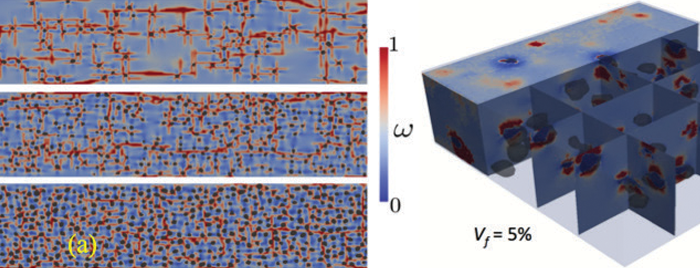A $5 million gift from Honda R&D Americas Inc. prompted the April 2015 launch of a center for virtual simulation and modeling of product performance and manufacturing processes in the College of Engineering at The Ohio State University. Researchers at the Simulation Innovation and Modeling Center, or SIMCenter, research and apply computer aided engineering techniques in the six identified thrust areas: solid mechanics, fluid mechanics, digital manufacturing, multi-physics, system integration and optimization. The Ohio Supercomputer Center provides the SIMCenter with co-location services and its researchers with access to high performance computing storage systems.
One Ohio State faculty member already leveraging the services of OSC and the SIMCenter, Soheil Soghrati, Ph.D., an assistant professor of mechanical and aerospace engineering as well as materials science and engineering, is studying the development and implementation of new numerical techniques for the automated modeling of problems with complex forms and structures, or morphologies.
“The finite element method (FEM), is one of the most widely used numerical techniques for the analysis and computational design of engineering structures and materials systems,” Soghrati said. “With advanced methodologies, researchers can significantly decrease the development time of the computational model, which reduces both the labor cost and the probability of human error during this process. Moreover, for problems such as heterogeneous and composite materials, the intricate microstructure of the problem can prohibit the straightforward application of FEM.”
The first step of Soghrati’s approach was to implement a more advanced numerical technique that sidestepped the burden of creating conforming finite element meshes, where adjacent elements share a whole edge or face forming the shape of the item being modeled. His research team recently developed a hierarchical interface-enriched FEM (HIFEM), which enables modeling multiphase problems with highly complex microstructures using finite element meshes that are completely independent of the shape.
The automated construction of HIFEM models, featuring up to 120 million elements, require the use of advanced computational geometry algorithms to determine the location of materials interfaces and evaluate the enrichment functions. The large number of geometric calculations required for creating such models, Soghrati explained, cannot be treated efficiently without the parallel computing capacity. Thus, Soghrati’s team developed a fully parallel computing paradigm for the automated treatment of such large-scale problems in multi-processor environments.
“The ultimate goal of this ongoing research is to further enhance the capability for automated modeling and simulation of problems with more than one billion elements,” Soghrati said.
Project Lead: Soheil Soghrati, Ph.D., The Ohio State University
Research Title: An automated computational approach for the treatment of problems with complex geometries
Funding Source: The Ohio State University
Website: https://acml.engineering.osu.edu/

